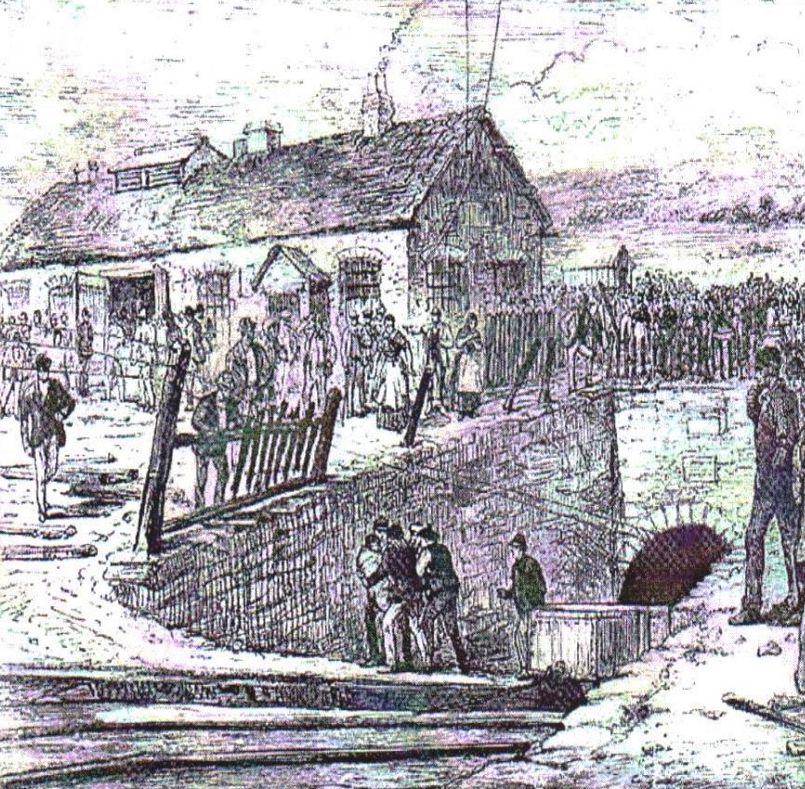Tondu, Bridgend (SS 8792 8352)
In 1770 a colliery was started at Cefn, about a mile to the west and in 1834 another was opened at Bryndu about 2 miles to the west of Park Slip. Morfa colliery when there was an explosion in 1890 with the loss of 87 lives lay about seven miles to the west. Some shafts had been sunk to the east of Tondu but the seam there is practically untouched. Park Slip was on the edge of almost virgin coal and was commenced in 1864 by the Llynfi, Tondu and Ogmore Coal and Iron Company who became North’s Navigation Colliery Company Limited in 1899.
This mine attempted to work the difficult geology near the southern outcrop with its take being to the south-west of Tondu. Two slants were driven, fifteen yards apart, one for hauling the men, coal and materials and for the intake of air, and the other for pumping water out of the mine and for the return airway.
The seams dipped at an angle of 26 degrees so the system of working them was to drive horizontal headings into the seam every 150 yards and then every 60 yards along these headings drive off ‘jigs’ for 25 yards until a continuous coalface of 400 to 500 yard is opened to the rise. By the time of the explosion in 1892, there were eight horizontal levels off the main road with the deepest, the No.8 being 1,166 yards from the surface.
The assistant inspector of mines for South Wales inspected this slant on the 4th of November 1882 and found a layer of gas one foot deep, it was an explosive mixture and men had been allowed to work there. He instructed that the men leave the mine. Griffith Roberts the fireman was fined £2 for one breach of rule and one shilling each time for another four breaches. David Powell, another fireman was fined £2.1s. The manager, David Jones, was summoned for not withdrawing the men in times of danger. He was fined £5. On the other side, Edward Jones, Edward Thomas, and William Jenkins, all colliers, were fined £2 for having unlocked safety lamps on the 18th of September 1882.
On the 26th August 1892 a massive explosion of gas killed 112 miners and following that the colliery lay idle until 1896 when it was employing 210 men underground and 58 men on the surface, the manager was Thomas Twist.
The colliery was the property of Colonel Norton’s, North’s Navigation Collieries (1899) Limited and was near Tondu on the Llynfi and Ogmore Railway where it passed over the southern outcrop of the South Wales coalfield. The line of the outcrop is from Llantrisant on the east to Port Talbot on the west where the coal basin entered the Bristol Channel. Few collieries had been established along this outcrop but small-scale workings had been worked along this line for more than 100 years before this disaster. It was closed in 1904.
In March 1918 the owners purchased 3,000 acres adjacent to Park Slip, intending to re-open and sink three new pits. By November 1919 the newspapers reported that the water had been pumped out to a depth of 150 yards and a little coal was being worked. In March 1920 the company reported that the new plans had been delayed by the war and difficulty in finding trained labour. Park Slip was being pumped clear of water but no start had been made on the pits. It was then re-opened for a short while in 1924 when it worked the Gellideg seam, which it called the Cribbwr Fawr, at a thickness of between 54 inches to 66 inches.
In 1927 it was shown as being owned by North’s Navigation Collieries Ltd. In 1893 the manager was Jason Willis Davison in 1922 it was managed by W. Thomas and in 1925 by J.J. Martyn.
The Upper-Nine-Feet seam was also worked it was called the Nine-Feet, and had a thickness of 7 feet 8 inches of mixed coal and dirt. There were eighteen main seams in this area in 1,200 feet of vertical ground they totalled a combined thickness of 97.5 feet to give an average thickness of 5.5 feet.
Park Slip West is now part of the Margam Opencast Site.
Some other incidents:
- On the 28th of September 1880, John Condon, aged 21 years, and a hitcher was hit by a haulage chain and killed.
- On the 29th of May 1883, Robert Webster, aged 18 years, and a coal trimmer on the surface of the mine fell into small coal and suffocated.
- On the 18th of November 1887, David Jenkins, aged 18 years, and a jigger was run over and killed by trams.
- On Wednesday, 2nd April 1884, an explosion at this mine killed two men, David Jones and W. Howell, one of them was the son of the manager. Seventeen others were injured.
Manpower (where known):
- 1889: Output: 79,955 tons.
- 1894: Output: 20,000 tons.
- 1896: 296.
- 1899: 354.
- 1900: 456.
- 1901: 467.
- 1902: 475.
- 1903: 420.
- 1922: 200.
- 1923: 100.
- 1924: 200.
- 1925: 100.
This information has been provided by Ray Lawrence, from books he has written, which contain much more information, including many photographs, maps and plans. Please contact him at welshminingbooks@gmail.com for availability.
Return to previous page


